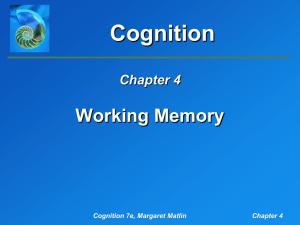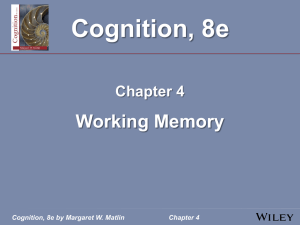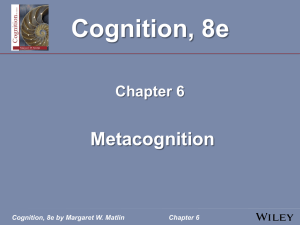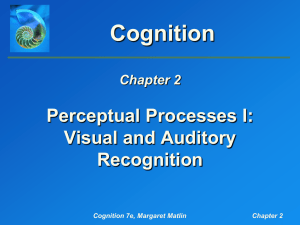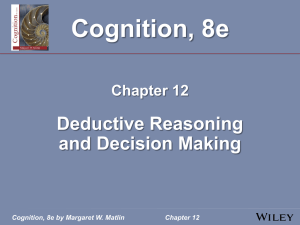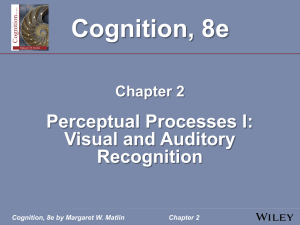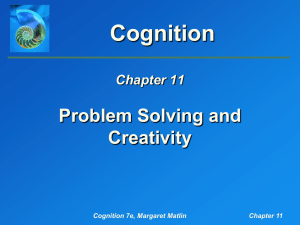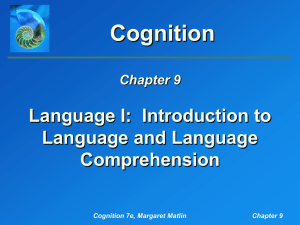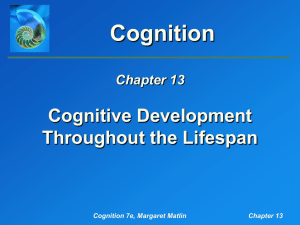Cognition, 8e by Margaret W. Matlin Chapter 9 Cognition, 8e
advertisement
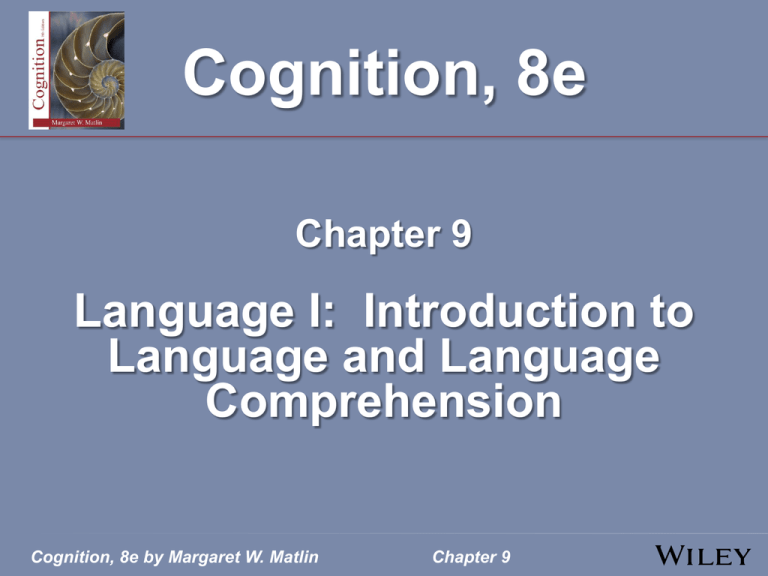
Cognition, 8e Chapter 9 Language I: Introduction to Language and Language Comprehension Cognition, 8e by Margaret W. Matlin Chapter 9 The Nature of Language syntax grammar semantics pragmatics Cognition, 8e by Margaret W. Matlin Chapter 9 The Nature of Language A Brief History of Psycholinguistics Chomsky's Approach • Language abilities can be explained in terms of a complex system of rules and principles represented in the minds of language users. • Humans have an innate understanding of the abstract principles of language. • Language learning involves the more superficial characteristics of a particular language. Cognition, 8e by Margaret W. Matlin Chapter 9 The Nature of Language A Brief History of Psycholinguistics Chomsky's Approach (continued) • Language is modular (language is special, not processed the same as other cognitive tasks). • surface structure vs. deep structure of sentences • transformational rules • ambiguous sentences Cognition, 8e by Margaret W. Matlin Chapter 9 The Nature of Language Factors Affecting Comprehension Negatives Clark & Chase (1972) • Negative statements require more processing time than affirmative statements. • Affirmative statements produce fewer errors. • Multiple negatives decrease performance. Cognition, 8e by Margaret W. Matlin Chapter 9 The Nature of Language Factors Affecting Comprehension The Passive Voice Ferreira and her coauthors (2002) • sentence plausibility • The active form of a sentence is easier to understand than the passive form. Cognition, 8e by Margaret W. Matlin Chapter 9 The Nature of Language Factors Affecting Comprehension Complex Syntax difficult to understand can result in memory overload nested structure working memory Cognition, 8e by Margaret W. Matlin Chapter 9 The Nature of Language Factors Affecting Comprehension Ambiguity Ambiguous Words People pause longer when they are processing an ambiguous word. When people encounter a potential ambiguity, the activation builds up for all the well-known meanings of the ambiguous item. Cognition, 8e by Margaret W. Matlin Chapter 9 The Nature of Language Factors Affecting Comprehension Ambiguity Ambiguous Words People are likely to choose one particular meaning: 1. if that meaning is more common than the alternate meaning 2. if the rest of the sentence is consistent with that meaning Cognition, 8e by Margaret W. Matlin Chapter 9 The Nature of Language The "Good-Enough" Approach to Language Comprehension People typically manage to read quite rapidly. The good-enough approach—Ferreira and colleagues • People frequently process only part of a sentence. • People usually do not work hard to create the most accurate, detailed interpretation of every sentence they read or hear. Cognition, 8e by Margaret W. Matlin Chapter 9 The Nature of Language The "Good-Enough" Approach to Language Comprehension The good-enough approach—Ferreira and colleagues • People read quickly, and they try to grasp the general meaning of a sentence. • Knowledge of language typically leads to an accurate interpretation. • This strategy can sometimes lead to errors in language comprehension. Cognition, 8e by Margaret W. Matlin Chapter 9 The Nature of Language In Depth: Neurolinguistics Individuals with Aphasia aphasia Figure 9.1: Broca's Area & Wernicke's Area • Broca's area/Broca's aphasia: expressivelanguage deficit • Wernicke's area/Wernicke's aphasia: receptive-language deficit Cognition, 8e by Margaret W. Matlin Chapter 9 Cognition, 8e by Margaret W. Matlin Chapter 9 The Nature of Language In Depth: Neurolinguistics Individuals with Aphasia People with Broca's aphasia may also have some trouble with language comprehension. Many people with Wernicke's aphasia have problems with language production as well as language comprehension. Cognition, 8e by Margaret W. Matlin Chapter 9 The Nature of Language In Depth: Neurolinguistics Hemispheric Specialization lateralization variations related to handedness Cognition, 8e by Margaret W. Matlin Chapter 9 The Nature of Language In Depth: Neurolinguistics Hemispheric Specialization Role in language left hemisphere • speech perception/sound interpretation • meaning • imagery right hemisphere • emotional tone • humor • more abstract language tasks Cognition, 8e by Margaret W. Matlin Chapter 9 The Nature of Language In Depth: Neurolinguistics Neuroimaging Research in Adults Without Aphasia 1. Using the fMRI method to study language in the left hemisphere. Kanwisher and colleagues • attempts to identify specific areas responsible for language comprehension tasks • individual differences Cognition, 8e by Margaret W. Matlin Chapter 9 The Nature of Language In Depth: Neurolinguistics Neuroimaging Research in Adults Without Aphasia 1. Using the fMRI method to study language in the left hemisphere. language-localizer task • compensates for individual differences • creates linguistic map for each person using complex language tasks • later, test each person on language and nonlanguage tasks Cognition, 8e by Margaret W. Matlin Chapter 9 The Nature of Language In Depth: Neurolinguistics Neuroimaging Research in Adults Without Aphasia 1. Using the fMRI method to study language in the left hemisphere. language-localizer task (continued) • Specific regions of left frontal lobe responded only to language tasks, but not to other kinds of cognitive tasks. • Other research has located portions of the left hemisphere that process specific linguistic information (e.g., sentences vs. non-words). Cognition, 8e by Margaret W. Matlin Chapter 9 The Nature of Language In Depth: Neurolinguistics Neuroimaging Research in Adults Without Aphasia 2. Using the fMRI method to study language in the right hemisphere. Gernsbacher and Robertson (2005): "A"/"The" study • virtually identical patterns of activation in left hemisphere • right hemisphere responded differently to connected language ("The" sentences) than to disconnected language ("A" sentences) Cognition, 8e by Margaret W. Matlin Chapter 9 The Nature of Language In Depth: Neurolinguistics How the Mirror System Can Facilitate Communication mirror system—a network of neurons in the brain’s motor cortex that are activated when you watch someone perform an action Cognition, 8e by Margaret W. Matlin Chapter 9 The Nature of Language In Depth: Neurolinguistics How the Mirror System Can Facilitate Communication Rizzolatti and colleagues • measure responses of single neurons • monkeys watching a researcher break open a peanut • Monkeys' responses while watching were similar to when the monkeys themselves broke open a peanut. Cognition, 8e by Margaret W. Matlin Chapter 9 The Nature of Language In Depth: Neurolinguistics How the Mirror System Can Facilitate Communication Calvo-Merino and colleagues (2005) • fMRI data for experts in classical ballet or martial arts • videos of classical ballet vs. videos of martial arts Cognition, 8e by Margaret W. Matlin Chapter 9 The Nature of Language In Depth: Neurolinguistics How the Mirror System Can Facilitate Communication Calvo-Merino and colleagues (2005) • fMRIs for experts in classical ballet showed significantly greater activation in the motorcortex areas relevant to ballet movements, and relatively little activation in the areas relevant to martial arts. Cognition, 8e by Margaret W. Matlin Chapter 9 The Nature of Language In Depth: Neurolinguistics How the Mirror System Can Facilitate Communication Calvo-Merino and colleagues (2005) • Individuals who were experts in martial arts showed the reverse activation pattern. • In other words, experts can grasp meaning by watching another person, when they have fully developed the appropriate motor ‘‘vocabulary.’’ Cognition, 8e by Margaret W. Matlin Chapter 9 Basic Reading Processes Reading Words: Theoretical Approaches How do we look at a pattern of letters and actually recognize that word? dual-route approach to reading—skilled readers employ both a direct-access route (recognize word directly through vision) and an indirect-access route (recognize word by first sounding out the word) Cognition, 8e by Margaret W. Matlin Chapter 9 Basic Reading Processes Reading Words: Theoretical Approaches The Direct-Access Route Bradshaw and Nettleton (1974) • pairs of words with similar spelling, but different sounds • first word read silently, second word pronounced out loud Cognition, 8e by Margaret W. Matlin Chapter 9 Basic Reading Processes Reading Words: Theoretical Approaches The Direct-Access Route Bradshaw and Nettleton (1974) (continued) • no interference indicated by no hesitation in pronouncing second word • Results suggest that people do not silently pronounce each word during normal reading. Cognition, 8e by Margaret W. Matlin Chapter 9 Basic Reading Processes Reading Words: Theoretical Approaches The Indirect-Access Route People often translate visual stimuli into sound during reading. Sound coding may enhance working memory. Cognition, 8e by Margaret W. Matlin Chapter 9 Basic Reading Processes Reading Words: Theoretical Approaches The Indirect-Access Route Luo and coauthors (1998) • pairs of words judged as related or unrelated in meaning • Students made errors on pairs where the second word sounds like a word that is semantically related to the first word (e.g., LION-BARE). Cognition, 8e by Margaret W. Matlin Chapter 9 Basic Reading Processes Reading Words: Theoretical Approaches The Indirect-Access Route Luo and coauthors (1998) (continued) • suggests they were silently pronouncing the word pairs when they made the judgments • few errors on pairs where the second word looked like a related word (e.g., LION-BEAN) Cognition, 8e by Margaret W. Matlin Chapter 9 Basic Reading Processes Reading Words: Theoretical Approaches The Indirect-Access Route Word sounds may be especially important when children begin to read. Children with high phonological awareness have superior reading skills. Cognition, 8e by Margaret W. Matlin Chapter 9 Basic Reading Processes Reading Words: Theoretical Approaches Dual-Route Approach • flexible • argues that the characteristics of the reading material determine whether access is indirect or direct • argues that characteristics of the reader also determine whether access is indirect or direct (e.g., beginning vs. advanced readers; poor vs. good readers) • consistent with brain-imaging research Cognition, 8e by Margaret W. Matlin Chapter 9 Basic Reading Processes Implications for Teaching Reading to Children Whole-word approach (direct access) • argues readers can directly connect the written word—as an entire unit—with the meaning that this word represents • argues that children should not learn to emphasize the way a word sounds • emphasizes context within a sentences Cognition, 8e by Margaret W. Matlin Chapter 9 Basic Reading Processes Implications for Teaching Reading to Children Whole-word approach (direct access) • problem—Even skilled adult readers achieve only about 25% accuracy when they look at an incomplete sentence and guess which word is missing. Cognition, 8e by Margaret W. Matlin Chapter 9 Basic Reading Processes Implications for Teaching Reading to Children Phonics approach (indirect access) • Readers recognize words by trying to pronounce the individual letters in the word. • "sound it out" • argues that speech sound is a necessary intermediate step in reading Cognition, 8e by Margaret W. Matlin Chapter 9 Basic Reading Processes Implications for Teaching Reading to Children Most educators and researchers support some sort of compromise. Whole-language approach • Reading instruction should emphasize meaning. • Reading instruction should be enjoyable, to increase children's enthusiasm about learning to read. Cognition, 8e by Margaret W. Matlin Chapter 9


